Introduction
- This guide describes how to setup registration of stops using state codes and when there is no production for an inactive time based on the ICT (Ideal cycle time) of the current product on a unit. This is basically a combination of Setup registration of stop code and of Setup registration of stop when no production dependet on the current product ICT on a unit
Flow of stop creation
This service first checks the state code, if it is not the run code, then a stop is created based on the state code. If the state code is the run code, then the service checks if the last production active is within the period given by the ICT of the current product, if it isn't a small stop is creates.
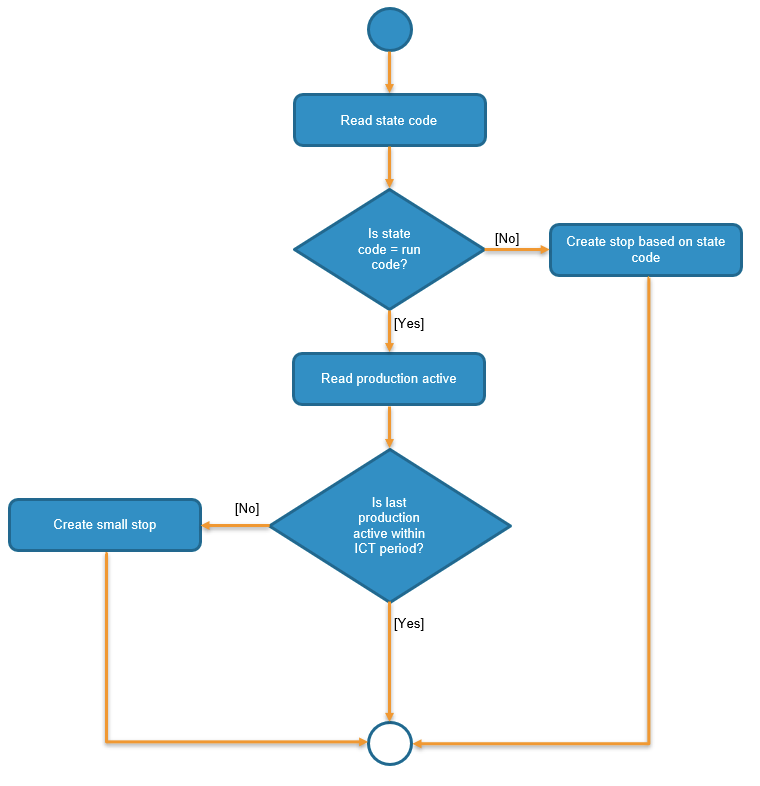
Setup
Go to the Configuration ->Data source page:
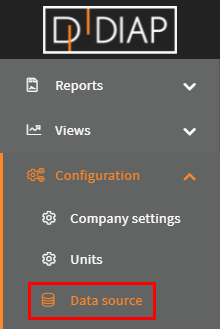
Select the unit you wish to setup the registration for(The units here are examples and are different from yours):
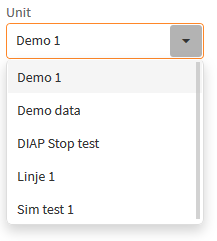
Click the Add button:

Select Stop by code and when no production - ICT Dependent:
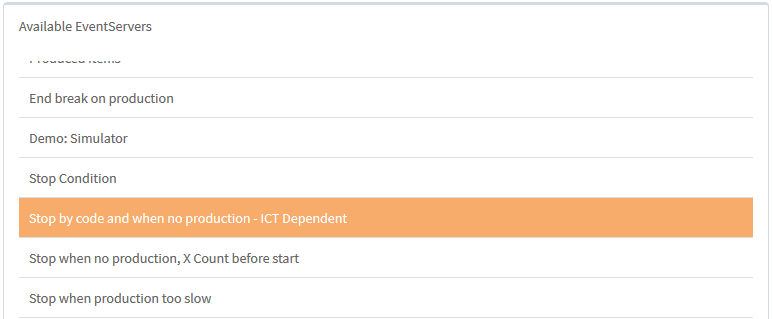
Configuration of Stop by code and when no production - ICT Dependent
- Name: The name of the event server, that is collecting the data.
The state code part of this service uses:
- Registration Type: The registration type that is used. There are the following type:
- Keep stop reason: This type keeps the first registered stop reason between run registrations. Use this type when the first stop code should represent the stop.
- Start new stop: This type starts a new stop reason for each different stop codes registered between run registrations. Use this type when each stop code registered in a stop should have a representation of the stop(as a series of stops adjacent to each other).
- Change stop reason: This type uses the last registered stop reason between run registrations. Use this type when the last stop code should represent the stop.
- Stop Code Tag: The Stop Code tag is where the stop codes are collected from. The structure of the name is [DIAP]-[PLC]-[Tag]
- Run Code: The code, that is used to state, that the unit is running.
The production part of this service uses:
- Small stop time: This is how long a small stop can last in seconds. A stop is consisted a small stop as long as it hasn't lasted longer than this period.
- Small Stop Reason: This is the stop reason that is used with small stops.
- Production Tags: The Production tags is where the production counts are collected from. The structure of the name is [DIAP]-[PLC]-[Tag]
- No production Stop reason: This is the stop reason that is used, when the stop has lasted longer than Small stop time.
- Times ICT before no production: (See Example - Times ICT before no production, for more clarification on this setting) This is how many ICT periods of the current product on a unit, that must pass after the last production activity, before a stop is created. A ICT period is the seconds of the current ICT (ideal cycle time), that is used by the current product on a unit. (You can see more information about how a ICT is setup and selected here: ideal cycle time for units and products)
Stop Code tag data type
- Type: Double(It gets converted into an integer)
The expected data type is hold numbers like : 0, 1, 2, 3, 5.
Production tag data type
- Type: Double
The expected data type is decimal numbers like : 0.0, 0.1,1.
Example - Registration Type, Keep stop reason:
Run Code = 1.
A unit is running, then it receives the stop code 12, then 17 and last 20, with registration type set to Keep stop reason, the first stop code is used to represent the stop:

Example - Registration Type, Start new stop:
Run Code = 1.
A unit is running, when it receives the stop code 12, then 17 and last 20, with registration type set to Start new stop, all of the stop codes are used to represent the stop as more stops adjacent to each other:

Example - Registration Type, Change stop reason:
Run Code = 1.
A unit is running, when it receives the stop code 12, then 17 and last 20, with registration type set to Change stop reason, the last stop code is used to represent the stop:

Codes Setup:
For more information regarding setup of stop codes, see: Setup registration of stop code
Example - Times ICT before no production
The Times ICT before no production is used to resolve a period of seconds, that must pass after the last production activity, before a stop is created. This period is calculated this way:
Period = Times ICT before no production * Current ICT on unit and product
Say that you have set the Times ICT before no production to 3:
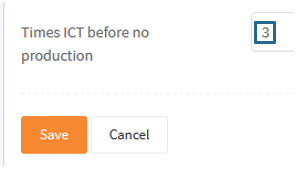
The Current ICT on unit and product is based on the unit, that the event server is configured for. Here we have selected Demo 1:
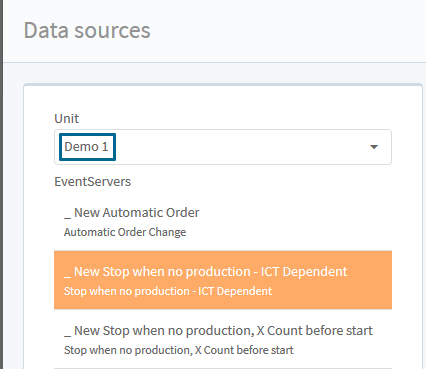
And the current product, that is being produced(Here we are producing Product1, you can see this information on the page Views -> Productions status)
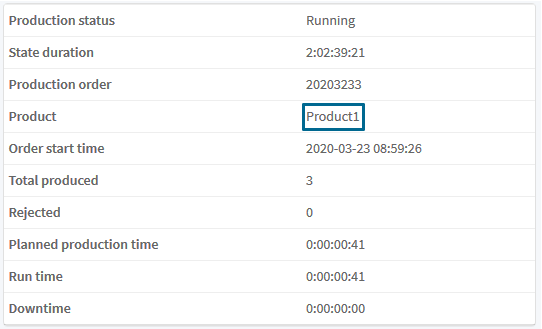
Now we see what the ICT is for Product1, when it is produced on Demo 1 (You can see more information about how a ICT is setup and selected here: ideal cycle time for units and products) Here the Current ICT on unit and product is 10 seconds
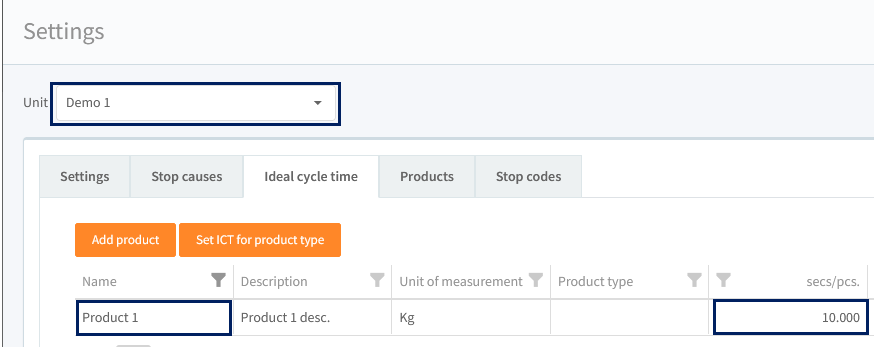
Now we can calculate the period:
Times ICT before stop occurs = 3
Current ICT on unit and product= 10 seconds
Period = 3 * 10 = 30 seconds
This means that if there has been no production activity within the last 30 seconds, then a stop will be created.
Stops starts with a duration of the current product ICT
When a stop is created, it will start with a duration based on the ICT from the current product on a units. If we take the example from above(see Example - Times ICT before no production), then the stop will start with a duration of 10 seconds.
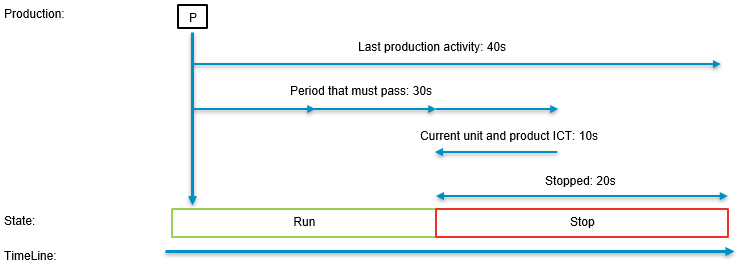
Example - Configure Stop by code and when no production - ICT Dependent
Select a name for the event server, that is collecting the data. Here we called it "Stop by code and when no production - ICT Dependent":

Set how long a small may last in seconds. Stops that last to this period and not longer, are consisted small stops. Here we set it to 30 seconds:

Select a small stop reason, when a small stop is created, it uses this stop reason. Here we used "Small Stop":

Select a registration type, this decide whether the first stop code(Type Keep stop reason), all of the stop codes(Type Start new stop) or the last stop code represent the stop(Type Change stop reason), Here we used "Start new stop":

Select the Stop Code tag, where the state code data comes from. Here we selected "dev00225 - Demo - Tag 1":

Select a run Code, this code represent the run state of the unit:

Select the Production tags, where the production data comes from. Here we selected "dev00225 - Demo - Tag 2":

Select the stop reason, that will be used, when the stop has lasted longer than Small stop time. Here we selected "No Production":

Set how many ICT period must pass, before a stop is created. Here we sat it to 3 periods:

When you are done, the configuration should look something like this (But with your values):
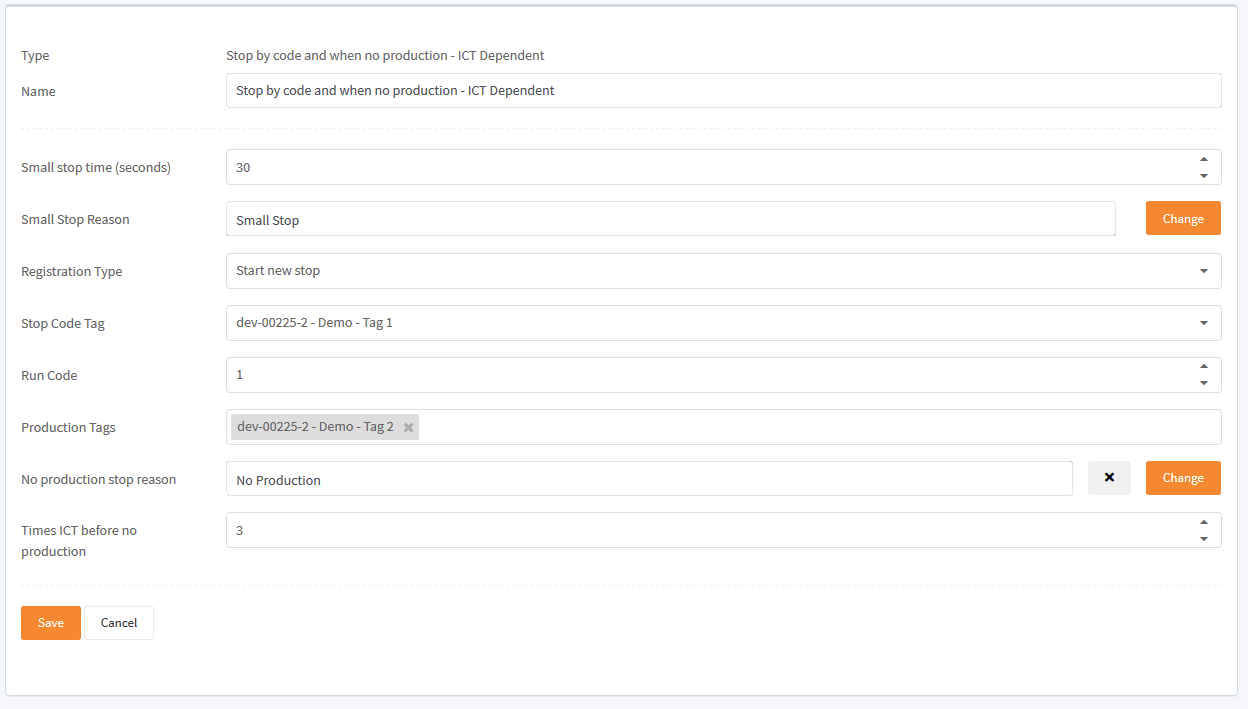
Click Save to save the configuration:

Now you have a configuration for checking state codes and production activity.
Start collecting data
When you have made your configurations in the Data source, then you need to start the event server for the configuration, so the data get collected.
Go to the Configuration->Data source status page:
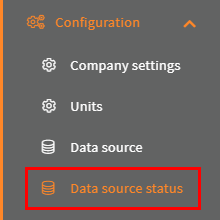
Select your unit:

Click the switch for the event server with the configuration:


Then the light turns green and the Last run timestamp is updated, when your event server has run your configuration for the first time:

That it. Now your configuration are done and you are collecting data.
